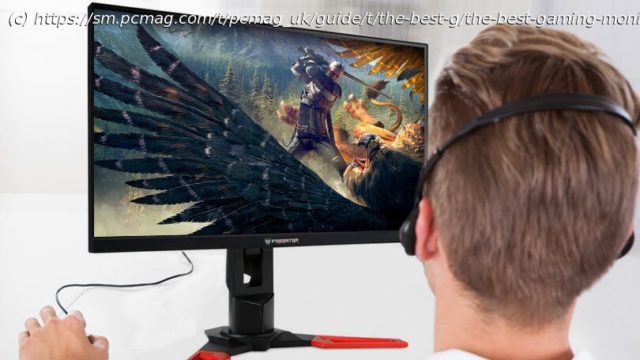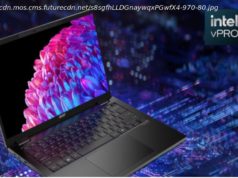Elevate your game with a monitor that plays as hard as you do. See what to look for in a gaming display, along with our top-ranked models; we’ve got deep-dive reviews of the best screens on the scene.
Whether you’re a serious PC gamer or a casual after-hours warrior, your hardware can be the pivot point between victory and defeat. To get the most from the latest first-person shooter (FPS), sports, racing, and other fast-action games, you’ll not only need a gaming PC with a powerful graphics card, but also a monitor that can render the action without subjecting you to blurred images, flicker, tearing, and other motion artifacts. In this guide, we’ll help you choose a display that gives you an edge over your opponents while delivering a smooth, immersive gaming experience. Here are the factors to consider when choosing a gaming monitor, as well as our current favorites from our extensive hands-on testing. Panel Size and Resolution When it comes to gaming monitors, bigger is almost always better. That said, in some cases you’ll want to keep the size of your screen to no more than 27 inches measured diagonally. If you’ve watched any esports tournaments lately, you’ve likely noticed that all the players are focused on screens smaller than that size. (24.5 inches seems to be the sweet spot, especially for esports-focused displays like the Asus ROG Swift 360Hz PG259QN.) Why? Well, if you’re playing a highly competitive title such as Counter Strike: Global Offensive or League of Legends, having a smaller screen means you can keep the monitor closer to your eyes while also keeping more of the frame in view. Being able to see every element on screen at once is a vital advantage in a competitive multiplayer environment. The larger your screen, the more difficult it is to keep every enemy combatant in your peripheral vision. If you have the room and don’t care so much about ultra-competitive gaming, however, a larger monitor provides plenty of space for your avatars and characters to roam and offers the opportunity to go beyond full high definition (known as full HD or 1080p and measuring 1,920 by 1,080 pixels). Many newer models are Wide Quad High-Definition (WQHD) monitors with 2,560-by-1,440-pixel resolution (also dubbed 1440p). The higher pixel count provides sharper imagery than full HD, but you’ll need a reasonably powerful graphics processor to play the latest games at the higher resolution, especially if you have all the visual effects and eye candy enabled. This goes double for 4K or ultra high definition (UHD) screens with a resolution of 3,840 by 2,160 pixels, such as the Acer Predator XB3. If desk space is tight, there are plenty of 24-inch monitors available, but with most of them you’ll be limited to 1080p resolution. If you have lots of room and money is no object, jumbo monitors are tempting. A 30-inch 4K display will deliver a stunning picture with amazing resolution; you can go all out with a 34-inch ultrawide monitor with either a flat or curved panel; or you can splurge on something larger still. (We’ve tested displays up to 65 inches.) Ultrawide monitors typically have a 21:9 aspect ratio (as opposed to the 16:9 ratio of 1080p,1440p, and 4K) and offer a much wider field of view than a standard monitor, but they take up a lot of room. A curved widescreen monitor enhances the immersive aspect by making you feel a bit closer to the action, and in some games the wraparound view will also give you a competitive edge. Battle-royale titles like PlayerUnknown’s Battlegrounds and Apex Legends both support 21:9 resolution. Rather than simply squashing and stretching the image as some games do, these games (and others with native 21:9 support) will actually show more of the battlefield on either side than you’d see on a 16:9 panel. Battle-royale players in particular will benefit from this increased real estate. A player on a 16:9 panel may not see an enemy standing on a hill far off in the periphery, but a 21:9 player might be able to spot the threat without having to turn their character. Panel Technology You’ll see several main panel technologies used in different gaming monitors, and each has its pluses and minuses. Twisted nematic (TN) panels are the most affordable and are popular among gamers because they offer fast pixel response times and refresh rates. Their biggest drawback? They’re prone to color shifting when viewed from an angle. Vertical alignment (VA) screens are known for their high native contrast ratios, robust colors, and ability to display deep blacks, but they’re also known to produce noticeable ghosting effects or blur fast-moving images, which can hurt gaming performance. It depends on the model, which is where reading PCMag’s and other reviews comes in. In-plane switching (IPS) panels provide superb all-around color quality, strong grayscale performance, and wide viewing angles, but they can’t match the fast pixel response of TN panels and are subject to motion artifacts. They’re the best general-use monitor type, but discriminating gamers or competitive esports types may want to avoid IPS. This changed in 2019, however, when LG developed a new variation (dubbed Fast IPS, Rapid IPS, and Nano IPS by various manufacturers) that claims 1-millisecond gray-to-gray response time with overdrive turned on. These panels use a thin layer of nanoparticles applied to the backlight that enables wider color-gamut coverage and reduces response time, a combo that now makes Fast IPS the dominant choice for almost every midrange and premium gaming monitor. If you have room in your budget, Fast IPS monitors currently offer the best balance of gaming performance and image quality. Organic light-emitting diode (OLED) and Quantum Dot OLED (QD-OLED) panels are the latest to arrive to the gaming display party, and also one of the most anticipated. OLED tech has been a staple in HDTV sets since 2018 or so, but it wasn’t until 2021 that the first OLED TV/monitor hybrids in LG’s C series gained traction. The same design also made it into the Alienware 55 OLED, a monitor we marked down for its minimal brightness and overall HDR performance. Most recently, though, Samsung has spiced up the competition with Dell’s help, launching the Editors’ Choice award-winning Alienware 34 QD-OLED. This ultrawide, curved QD-OLED panel is both less expensive and faster than the Alienware 55 and brings QD-OLED into the gaming-panel conversation right out of the gate.






